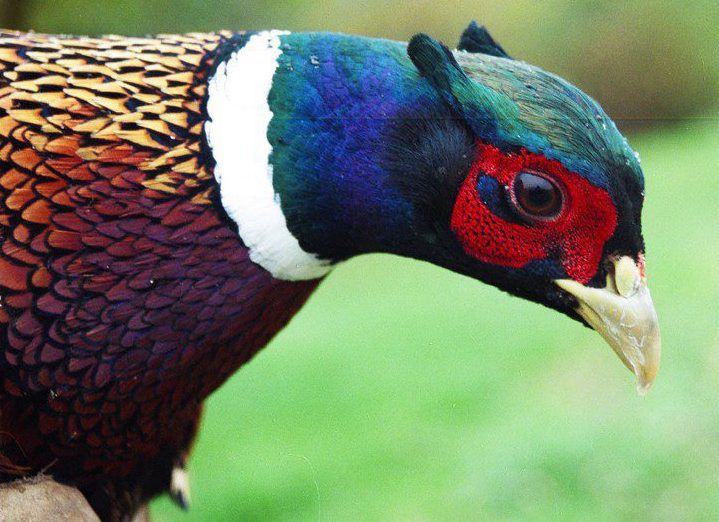
- Goose
- Cogito ergo sum
 Offline
Offline 
- Registered: 1/29/2015
- Posts: 13,427
Pheasants in Pennsylvania: End of the trail?
Pheasants in Pennsylvania: End of the trail?
To the hunter who can’t stand the thought of giving up walking through a frost-covered thicket with a coiled bird dog, ever hoping for that magical flush of a ring-necked pheasant.
To Lancaster County residents who don’t even hunt but still thrill at the unexpected sight of a pheasant rooster on a fence post or catch a mating cackle in spring.
Joe Seibert wants you to buy the Pennsylvania Game Commission’s new, controversial $25 annual pheasant stamp.
“I know they are not native birds. But that is my quest, that everybody who has the means to, to purchase a stamp so that they might have the opportunity to hear that and see that.”
If there isn’t a strong response to buy the stamps, the Landisville senior and dedicated upland game hunter is convinced that pheasant hunting will be phased out by the Game Commission, which has been stocking pheasants in the state since 1915.
There is a lot riding on the sale of the stamps to partially offset the considerable expense of the Game Commission’s pheasant-rearing and stocking program, acknowledges Robert Boyd, who oversees the pheasant propagation program.
The agency’s first plan when it was denied a license increase by the state legislature yet again last year was to pull the plug on the $4.7 million pheasant program altogether, Boyd revealed in an interview. That drastic action was never made public.
But a discussion on the unpopularity of such a cut — especially without giving hunters a chance to help save the program — resulted in the pheasant stamp idea.
“This permit, if it works — that’s another thing that is going to save this program,” Boyd said.
The backdrop story is well-known. Pheasants, natives of China, took to the farmland and grassy edgelands of much of Pennsylvania. Around 1970, the state had the highest density of pheasants in the nation.
It’s been downhill ever since as farmland practices changed, wetlands were drained, hedgerows were erased and land development sprawled.
Wild pheasants in Pennsylvania “are virtually nonexistent today,” the Game Commission said in a 2014 report.
The number of pheasant hunters in the state has fallen from 700,000 in 1971 to somewhere around 86,000 today.
In recent years, an experiment to intensively manage four good-habitat blocs of land in hopes of proving that pheasants can make a comeback if the conditions are right has been largely a bust.
Still, the agency has continued an expensive put-and-take stocking all these years to satisfy the hearts of hunters who love the sport and its unique rituals, including the dance with dogs.
“The trend for small-game hunters is down 37 percent in the last 10 years, but pheasant hunters remain stable,” Boyd notes, adding that the junior pheasant hunting season has been one of the agency’s most successful tools for recruiting young hunters.
“It still provides a lot of hunting opportunities. Fifty-three percent of our hunters say they have hunted pheasants at some time in the past.”
It costs the agency about $26 to raise each bird it stocks. And most end up in the jaws or talons of a predator and not in a hunter’s game bag.
But with the state legislature withholding a basic hunting license fee increase going on 18 years now, raising and stocking pheasants has became too expensive for nostalgia’s sake.
In January, two of the commission’s four pheasant game farms were closed, reducing this autumn’s upcoming stockings around the state from 215,000 to 170,000.
And now the pheasant stamp that even seniors who purchased lifetime licenses will have to pay to hunt ringnecks.
The stamp has received mixed reviews.
Some hunters are irritated that it’s yet another extra fee they are expected to pay on top of a regular license even as the number of stocked pheasants statewide is being reduced.
Others say it should have been introduced years ago to bolster the state’s flagging pheasant program.
Seibert, 65, sees it as a mandate on whether to close the book on pheasant hunting in Pennsylvania. He’s started a campaign to talk hunters and nonhunters alike into buying a pheasant stamp. He fears that if there are meager purchases, the Game Commission will pull the plug on pheasant raising and stocking for good.
“Upland bird hunting in Pennsylvania seems to be doomed,” he says, admitting a degree of pessimism.
“The grouse population is being decimated by West Nile virus. Quail hunting is long gone and now it looks as if pheasant hunting will be eliminated if hunters don’t support the new pheasant stamp.”
Seibert, who works his German short-haired pointer at least twice a week year-round and hunts on area game lands, maintains that eliminating pheasant hunting will have harmful effects throughout the sport world.
“It will have a ripple effect for dog breeders and companies that make accessories for dog training,” he says. “It will also affect birders of pen-raised chukars, pheasants and quail, which many bird dog owners use to train their dogs in preparation for the pheasant season.
“Fewer people will be interested in owning a bird dog which will affect the veterinary industry as well as suppliers of veterinary supplies.”
Boyd said the agency is hoping for the sale of pheasant stamps to generate $1.5 million, not enough to underwrite the entire program, but at least a show of support for a sport that still generates memories for a certain breed of hunter.
We live in a time in which decent and otherwise sensible people are surrendering too easily to the hectoring of morons or extremists.
- MarcelKoss
- Rookie Exchanger
 Offline
Offline - Registered: 1/18/2024
- Posts: 4
Re: Pheasants in Pennsylvania: End of the trail?
The story of the pheasant is truly mysterious and mysterious to me. The added getting over it adds new knowledge to me.
 1 of 1
1 of 1